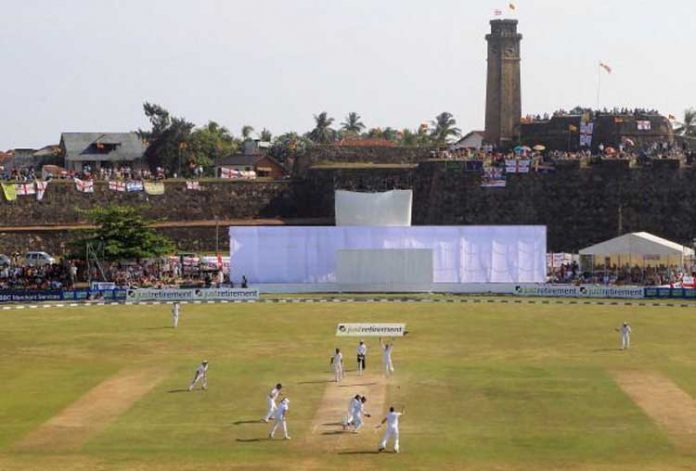Wouldn’t it be a crying shame if Galle were to be stripped of Test status? The Galle International Stadium is one of the most picturesque cricket grounds in the world along with Newlands in Cape Town and Queenstown Events Center in New Zealand. Many are the international players and visitors who have marveled the beauty of the venue with the Dutch Fort and the Indian ocean soothing the eyes.
The venue staging international matches in future hangs on the balance and this year’s opening Test match against England could be the last staged at this iconic venue.
Built by the Portuguese in 1588, the Fort was modified extensively by the Dutch. It is a UNESCO World Heritage Site.
Staging international cricket in this beautiful venue was the brainchild of Thilanga Sumathipala and hence New Zealand played the first Test match here 20 years ago. When there were political undercurrents to grant Test status to Uyanwata Stadium in Matara, Sumathipala resisted such moves with an iron will insisting on Galle retaining Test status.
Since Galle International Stadium hosted the first Test match in 1998, the venue has been a constant port of call for visiting cricket teams.
The future of the venue is facing serious threat. The bone of contention is that the pavilion, media center, dressing rooms and broadcasting area that were built in 2006 were done without approval from Ministry of Cultural Affairs and Archeological Department. Those that want the pavilion demolished argue that the Galle Fort must be visible from the main bus stand for it to remain a World Heritage Site.
The issue first surfaced more than ten years ago when objections were raised for the new constructions. Galle’s strongman Jayananda Warnaweera then came up with a smart plan to resist objections. He named the new facilities as Mahinda Rajapaksa Pavilion overnight and none dared to take up the issue from thereon.
The matter has resurfaced again with President Rajapaksa out of power and Warnaweera banned from all cricket activities by the ICC.
While all Sri Lankans would want the Galle Fort to remain a World Heritage Site, they will also want to see the venue hosting Test matches. Moving cricket to another location in the Galle district is not the answer, but that’s what certain politicians from Galle seem to be wanting.
One of the most looked forward to activities by visiting teams and fans when they come to Sri Lanka is to play cricket in Galle. Some of the memorable moments of the game have taken place here like Muttiah Muralitharan’s farewell Test match and Shane Warne’s return to cricket from a drug ban. This is also where some of the leading figures of the game like Kumar Sangakkara, Ricky Ponting and Michael Clarke made their debut as Test captains.
This is sad! Galle cricket ground has a unique place in international test cricket history for its location. Also one of the most successful venues for the national team. I would like to plead and humbly request authorities and SL government to reconsider this decision.. https://t.co/H01PlNANAH
— Mahela Jayawardena (@MahelaJay) July 19, 2018
There has been outrage among public and fans upon being told that Galle might not host any international cricket from 2019 onwards and rightly so. Galle District MP Chandima Weerakkody even raised the issue in Parliament on Wednesday.
When so many historical places of archeological value have been vandalized in recent times, we wonder whether the sole reason for the venue to be stripped of Test status is due to archeological importance alone.
Already politicians have picked up a location where the Galle district’s next international venue will be built. SLC certainly cannot afford to spend a colossal amount on another cricket ground. Don’t forget that the Suriyawewa International Stadium cost the board an arm and leg and the venue today has become a white elephant.
The need of the hour is not shifting Galle’s cricket from its current location to another. In this day of engineering marvels, there should be a way out of the current predicament. SLC will be able to find the answers if they ask the right people.
In 2005, there were similar moves to take Galle’s Test cricket from the current location to Habaraduwa. The excuse the authorities put up at that time was that if tsunami struck again while a game of cricket was on progress, the loss of life would be massive. An angry Kumar Sangakkara responded saying, “If I were to die while playing cricket, then so be it!’
When the issue was further debated 13 years ago, it emerged that there was a sinister move to take cricket to Habaraduwa, a few kilometers from Galle, so that the new facility could be named after a powerful Minister. Sanity prevailed and that move was shot down.
Politicians are too clever to achieve their means through manipulation and maneuvering at the expense of the game.
Take for example the Pallekele International Stadium. When the venue was built at the dawn of the new millennium we were told that the rainfall at Pallekele was the lowest in the country and it was the ideal location to host cricket matches as the games were being affected by inclement weather frequently. Ever since, every time a cricket match is played at Pallekele it rains cats and dogs. Little did we realize at that time that Pallekele was the electorate of the Sports Minister at that time!




















